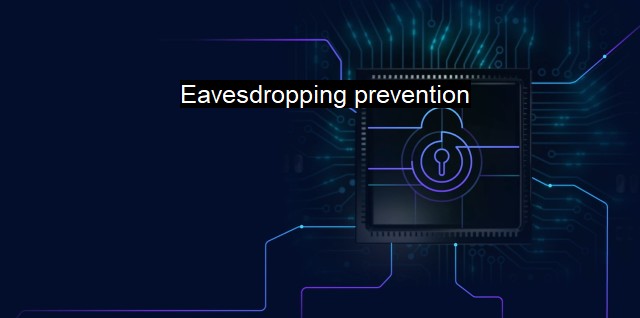What is Eavesdropping prevention?
Eavesdropping Prevention: Safeguarding Electronic Communication Channels from Cyber Threats
'Eavesdropping Prevention' is a key aspect in the larger domain of cybersecurity and antivirus measures, where it ensures the robustness of secure communication lines and resilience against cyber threats. Predominantly focusing on avoiding unauthorized third-party listeners from infiltrating private conversations or data exchanges, eavesdropping prevention employs various methods and technological tools to safeguard privacy, confidentiality, and secure exchanges in both digital and physical forms of communication.Broadly speaking, eavesdropping can happen in any form of interaction – be it face-to-face conversations, phone calls, emails, or data transfer over a network. Given the exponential increase in connected digital devices, the online landscape acts as a fertile ground for threat actors to eavesdrop on unsuspecting victims. Modern cybersecurity apparatus deploys advanced mechanisms to prevent eavesdropping and minimize the risks associated with data breaches.
In terms of network security, eavesdropping is often classified in two segments – passive and active. While passive eavesdropping refers to unauthorized listeners stealthily garnering information without disrupting the network’s operations, active eavesdropping or interference may involve hackers making changes to the communication lines which could lead to data breaches or compromised interaction.
Preventing eavesdropping becomes critical in cases involving sensitive data exchanges, financial transactions, corporate dealings, intellectual property, government communications, and military information, among others. Antivirus software, firewalls, intrusion detection tools, and secure communication protocols all form part of an effective eavesdropping prevention strategy.
Encryption is one of the primary modes of securing data by rendering it unreadable to everyone except the holder of the decryption key. Technologies such as SSL and HTTPS are commonly used to encrypt data for transit in a network, while various encryption algorithms for storage ensure that even if data is intercepted, it remains indecipherable.
Simultaneously, maintaining up-to-date antivirus defenses can ward off most malware types, many of which act as eavesdropping tools. Well-developed antivirus software can detect and neutralize such threats before they can infiltrate the network or system.
Use of Virtual Private Networks (VPNs) for data transfer adds an additional layer of security, concealing your online activity from possible eavesdroppers by rerouting your data packets through a secure, encrypted tunnel. This makes it highly challenging for any unauthorized listener or hacker to track a user's location or the data that is being transmitted.
Biometric technologies incorporated in modern gadgets can prevent physical access to the device and hence limit the possibility of eavesdropping. Voice recognition, fingerprints, or retina scans can go a long way in making your device secure from physical gatecrashers.
Network monitoring services offer real-time monitoring to identify possible breach points and seal them instantly, combined with timely updates to identify and counteract new threats, these so-called 'ethical hackers' play a vital role in maintaining the robustness of security networks.
Likewise, user awareness and training are paramount to preventing eavesdropping, whereby good browsing habits, regular updates and patches, use of strong passwords and multi-factor authentication can drastically reduce vulnerability to cyber threats.
Frequent audits and compliance with industry cybersecurity standards like ISO 27001 and regulations like GDPR or CCPA are necessary to implement cutting-edge eavesdropping prevention.
Eavesdropping prevention involves a broad range of techniques and tactics that aim to secure communication lines and sensitive data from illegitimate access or breaches. As new threats continue to emerge, incorporating evolving technologies and maintaining cyber hygiene will undoubtedly strengthen eavesdropping prevention efforts and create an extensive line of defense against any would-be eavesdroppers.

Eavesdropping prevention FAQs
What is eavesdropping prevention?
Eavesdropping prevention refers to the measures taken to prevent someone from secretly listening to or intercepting private conversations or communications. In the context of cybersecurity and antivirus, it specifically refers to preventing hackers or cybercriminals from intercepting sensitive information such as passwords, credit card numbers, or other data.Why is eavesdropping prevention important for cybersecurity?
Eavesdropping prevention is critical for cybersecurity because it helps ensure that sensitive information remains secure and confidential. Hackers often attempt to intercept data transmitted over unsecured networks such as public WiFi or through unencrypted communications channels. Without proper eavesdropping prevention measures in place, cybercriminals can easily steal information and use it for fraudulent purposes.What are some common eavesdropping prevention techniques?
Some common eavesdropping prevention techniques include using encrypted communications channels, implementing firewalls and intrusion detection systems, and limiting access to sensitive information on a need-to-know basis. Additionally, using strong passwords and regularly updating software and security protocols can help prevent eavesdropping and other cybersecurity threats.What should I do if I suspect eavesdropping or a security breach?
If you suspect eavesdropping or a security breach, it is important to act quickly to mitigate the potential damage. This may include changing passwords, notifying law enforcement, or contacting a professional cybersecurity firm for assistance. In some cases, it may also be necessary to disconnect from the internet or shut down affected devices to prevent further damage or data loss.| | A | | | B | | | C | | | D | | | E | | | F | | | G | | | H | | | I | | | J | | | K | | | L | | | M | |
| | N | | | O | | | P | | | Q | | | R | | | S | | | T | | | U | | | V | | | W | | | X | | | Y | | | Z | |
| | 1 | | | 2 | | | 3 | | | 4 | | | 7 | | | 8 | | |||||||